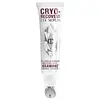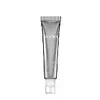What's inside
What's inside
 Key Ingredients
Key Ingredients

 Benefits
Benefits

 Concerns
Concerns

 Ingredients Side-by-side
Ingredients Side-by-side

Water
Skin ConditioningGlycereth-26
HumectantTriheptanoin
Skin ConditioningMaltodextrin
AbsorbentMethyl Gluceth-20
HumectantCamellia Oleifera Seed Oil
Skin ConditioningButyrospermum Parkii Oil
EmollientPhenoxyethanol
PreservativeAlcohol
AntimicrobialLecithin
EmollientCaesalpinia Spinosa Gum
Skin ConditioningDimethyl Isosorbide
SolventPolysorbate 20
EmulsifyingGlyceryl Stearate
EmollientSilica
AbrasiveOctyldodecyl Oleate
EmollientBenzyl Alcohol
PerfumingGlycerin
HumectantCaffeine
Skin ConditioningPEG-100 Stearate
Carbomer
Emulsion StabilisingOctyldodecyl Stearoyl Stearate
EmollientSodium Gluconate
Skin ConditioningSodium Hyaluronate
HumectantChondrus Crispus Extract
Skin ConditioningAscophyllum Nodosum Extract
Skin ConditioningEscin
TonicSodium Hydroxide
BufferingTocopheryl Acetate
AntioxidantAloe Barbadensis Leaf Juice
Skin ConditioningRosa Canina Fruit Extract
AstringentPolyhydroxystearic Acid
EmulsifyingOctyldodecanol
EmollientPotassium Phosphate
BufferingBiosaccharide Gum-4
Skin ConditioningPlumeria Alba Flower Extract
Skin ConditioningPlumeria Rubra Flower Extract
Skin ConditioningLithothamnion Calcareum Extract
Skin ConditioningParfum
MaskingWine
Skin ConditioningAmethyst Powder
AbrasiveMoonstone Powder
Skin ConditioningQuartz
AbrasiveRuby Powder
Skin ConditioningSolanum Tuberosum Pulp Extract
SmoothingAcetyl Tetrapeptide-11
Skin ConditioningAcetyl Tetrapeptide-9
Skin ConditioningCitric Acid
BufferingSodium Benzoate
MaskingPotassium Sorbate
PreservativeSuccinic Acid
BufferingDehydroacetic Acid
PreservativeLimonene
PerfumingGeraniol
PerfumingCitronellol
PerfumingLinalool
PerfumingWater, Glycereth-26, Triheptanoin, Maltodextrin, Methyl Gluceth-20, Camellia Oleifera Seed Oil, Butyrospermum Parkii Oil, Phenoxyethanol, Alcohol, Lecithin, Caesalpinia Spinosa Gum, Dimethyl Isosorbide, Polysorbate 20, Glyceryl Stearate, Silica, Octyldodecyl Oleate, Benzyl Alcohol, Glycerin, Caffeine, PEG-100 Stearate, Carbomer, Octyldodecyl Stearoyl Stearate, Sodium Gluconate, Sodium Hyaluronate, Chondrus Crispus Extract, Ascophyllum Nodosum Extract, Escin, Sodium Hydroxide, Tocopheryl Acetate, Aloe Barbadensis Leaf Juice, Rosa Canina Fruit Extract, Polyhydroxystearic Acid, Octyldodecanol, Potassium Phosphate, Biosaccharide Gum-4, Plumeria Alba Flower Extract, Plumeria Rubra Flower Extract, Lithothamnion Calcareum Extract, Parfum, Wine, Amethyst Powder, Moonstone Powder, Quartz, Ruby Powder, Solanum Tuberosum Pulp Extract, Acetyl Tetrapeptide-11, Acetyl Tetrapeptide-9, Citric Acid, Sodium Benzoate, Potassium Sorbate, Succinic Acid, Dehydroacetic Acid, Limonene, Geraniol, Citronellol, Linalool
Water
Skin ConditioningCaprylic/Capric Triglyceride
MaskingButyrospermum Parkii Butter
Skin ConditioningPropanediol
SolventArachidyl Alcohol
EmollientCetearyl Isononanoate
EmollientGlycerin
HumectantIsododecane
EmollientSqualane
EmollientEthylhexyl Palmitate
EmollientBehenyl Alcohol
EmollientCetearyl Alcohol
EmollientGlyceryl Stearate
EmollientMicrocrystalline Cellulose
AbsorbentPPG-12/Smdi Copolymer
EmollientTocopheryl Acetate
AntioxidantCyclodextrin
AbsorbentPhytosterols
Skin ConditioningPhenoxyethanol
PreservativeArachidyl Glucoside
EmulsifyingDimethicone
EmollientSodium Acrylates Copolymer
Tocopherol
AntioxidantLinoleic Acid
CleansingPandanus Conoideus Fruit Oil
EmollientCeramide NP
Skin ConditioningBisabolol
MaskingHydroxyacetophenone
AntioxidantSodium Stearoyl Glutamate
CleansingCellulose
AbsorbentHelianthus Annuus Seed Oil
EmollientLecithin
EmollientSodium Hyaluronate
HumectantRetinal
Skin ConditioningPentaerythrityl Tetra-Di-T-Butyl Hydroxyhydrocinnamate
AntioxidantLonicera Japonica Flower Extract
Skin ConditioningDaucus Carota Sativa Seed Oil
EmollientLonicera Caprifolium Flower Extract
PerfumingSodium Polyaspartate
HumectantXanthan Gum
EmulsifyingDisodium EDTA
Rubus Chamaemorus Seed Oil
Skin ConditioningEthylhexylglycerin
Skin ConditioningBHT
AntioxidantPentylene Glycol
Skin ConditioningSodium Hydroxide
BufferingTrihydroxystearin
Skin ConditioningWater, Caprylic/Capric Triglyceride, Butyrospermum Parkii Butter, Propanediol, Arachidyl Alcohol, Cetearyl Isononanoate, Glycerin, Isododecane, Squalane, Ethylhexyl Palmitate, Behenyl Alcohol, Cetearyl Alcohol, Glyceryl Stearate, Microcrystalline Cellulose, PPG-12/Smdi Copolymer, Tocopheryl Acetate, Cyclodextrin, Phytosterols, Phenoxyethanol, Arachidyl Glucoside, Dimethicone, Sodium Acrylates Copolymer, Tocopherol, Linoleic Acid, Pandanus Conoideus Fruit Oil, Ceramide NP, Bisabolol, Hydroxyacetophenone, Sodium Stearoyl Glutamate, Cellulose, Helianthus Annuus Seed Oil, Lecithin, Sodium Hyaluronate, Retinal, Pentaerythrityl Tetra-Di-T-Butyl Hydroxyhydrocinnamate, Lonicera Japonica Flower Extract, Daucus Carota Sativa Seed Oil, Lonicera Caprifolium Flower Extract, Sodium Polyaspartate, Xanthan Gum, Disodium EDTA, Rubus Chamaemorus Seed Oil, Ethylhexylglycerin, BHT, Pentylene Glycol, Sodium Hydroxide, Trihydroxystearin
 Reviews
Reviews

Ingredients Explained
These ingredients are found in both products.
Ingredients higher up in an ingredient list are typically present in a larger amount.
Glycerin is already naturally found in your skin. It helps moisturize and protect your skin.
A study from 2016 found glycerin to be more effective as a humectant than AHAs and hyaluronic acid.
As a humectant, it helps the skin stay hydrated by pulling moisture to your skin. The low molecular weight of glycerin allows it to pull moisture into the deeper layers of your skin.
Hydrated skin improves your skin barrier; Your skin barrier helps protect against irritants and bacteria.
Glycerin has also been found to have antimicrobial and antiviral properties. Due to these properties, glycerin is often used in wound and burn treatments.
In cosmetics, glycerin is usually derived from plants such as soybean or palm. However, it can also be sourced from animals, such as tallow or animal fat.
This ingredient is organic, colorless, odorless, and non-toxic.
Glycerin is the name for this ingredient in American English. British English uses Glycerol/Glycerine.
Learn more about GlycerinGlyceryl Stearate is a mix of glycerin and stearic acid.
It is used to stabilize the mixing of water and oil ingredients. By preventing these ingredients from separating, it can help elongate shelf life. It can also help thicken the product's texture.
As an emollient, it helps soften skin and supports barrier-replenishing ingredients.
In cosmetics, Glyceryl Stearate is often made from vegetable oils or synthetically produced.
This ingredient may not be fungal-acne safe
Fun fact: The human body also creates Glyceryl Stearate naturally.
Learn more about Glyceryl StearateLecithin is a term for a group of substances found in the cell membranes of plants, animals, and humans. They are made up of mixture of phospholipids.
This ingredient has emollient and emulsifying properties.
As an emollient, lecithen helps soften the skin and creates a barrier to keep moisture in.
As an emulsifier, it also helps prevent water and oil ingredients from separating. Lecithin can also help ingredients be better absorbed by the skin.
This is because the phospholipids in lecithin produce liposomes. Liposomes help other ingredients get through the skin barrier.
Depending on the source of this ingredient, lecithin may not be fungal acne safe. This is because some sources of lecithin come from soybean oil, which may feed the malassezia yeast that feeds fungal acne.
We recommend reaching out to the brand you are purchasing from to inquire about the source of their lecithin.
Some other names for this ingredient include soy lecithin and deoiled soy lecithin.
Learn more about LecithinPhenoxyethanol is a preservative that has germicide, antimicrobial, and aromatic properties. Studies show that phenoxyethanol can prevent microbial growth. By itself, it has a scent that is similar to that of a rose.
It's often used in formulations along with Caprylyl Glycol to preserve the shelf life of products.
Sodium Hyaluronate is hyaluronic acid's salt form. It is commonly derived from the sodium salt of hyaluronic acid.
Like hyaluronic acid, it is great at holding water and acts as a humectant. This makes it a great skin hydrating ingredient.
Sodium Hyaluronate is naturally occurring in our bodies and is mostly found in eye fluid and joints.
These are some other common types of Hyaluronic Acid:
Learn more about Sodium HyaluronateSodium Hydroxide is also known as lye or caustic soda. It is used to adjust the pH of products; many ingredients require a specific pH to be effective.
In small amounts, sodium hydroxide is considered safe to use. However, large amounts may cause chemical burns due to its high alkaline.
Your skin has a natural pH and acid mantle. This acid mantle helps prevent harmful bacteria from breaking through. The acid mantle also helps keep your skin hydrated.
"Alkaline" refers to a high pH level. A low pH level would be considered acidic.
Learn more about Sodium HydroxideTocopheryl Acetate is AKA Vitamin E. It is an antioxidant and protects your skin from free radicals. Free radicals damage the skin by breaking down collagen.
One study found using Tocopheryl Acetate with Vitamin C decreased the number of sunburned cells.
Tocopheryl Acetate is commonly found in both skincare and dietary supplements.
Learn more about Tocopheryl AcetateWater. It's the most common cosmetic ingredient of all. You'll usually see it at the top of ingredient lists, meaning that it makes up the largest part of the product.
So why is it so popular? Water most often acts as a solvent - this means that it helps dissolve other ingredients into the formulation.
You'll also recognize water as that liquid we all need to stay alive. If you see this, drink a glass of water. Stay hydrated!
Learn more about Water